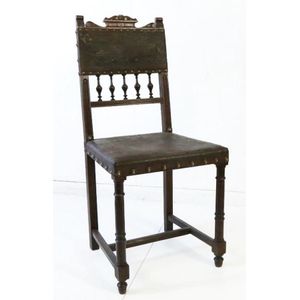Ash Lancashire Spindle Back Dining Chairs
You must be a subscriber, and be logged in to view price and dealer details.
Subscribe Now to view actual auction price for this item
When you subscribe, you have the option of setting the currency in which to display prices to $Au, $US, $NZ or Stg.
- Rush Seating - Associated with country style chairs, stools and settees, rush seats are woven from rushes, with the pattern of the weaving often dividing the the chair seat diagonally into four triangles.
The weaving of rushes has been practiced for centuries, and it is believed that some early rush seats of the 18th and 19th century were painted, although common practice now is to leave the rush in its natural state. As the rush ages the colour
Rushes of the type used in Europe for seating are not available in Australia, and instead fibre rush, a man-made product from one-ply twisted paper, is used. Another substitute material is twisted natural sea grass.
Seats in Danish furniture of the 1950s were often finished with Danish cord, a three ply twisted paper cord, which has a similar appearance to rush. - Stretcher - A horizontal rail which connects the legs of stools, chairs, tables and stands, to provide stabilisation of the legs. A stretcher table is any table with a stretcher base. The term is usually applied to substantial farmhouse tables, although many cabinetmaker's pieces, such as sofa tables, also have turned stretchers.
- Georgian - As an English stylistic period, Georgian is usually taken to cover the period from George I (1714) to the Regency of Prince George (1811-20), although the period from 1800 to 1830 is sometimes designated as the Regency period. During the Georgian period the great English cabinetmakers and designers such as Chippendale, Hepplewhite, Adam Sheraton etc., were all active.
Therefore there isn't a single 'Georgian style' as such and to say something is 'Georgian', usually means it was made between 1714 and 1830. This assumes we discount George V and George VI, both being from the 20th century.
The styles popular at the time of each reign were:
George I (1714-1727) saw out the last years of the Baroque period.
George II (1727-1760) reigned during the Rococo period.
George III (1760-1820) saw the last gasp of the Rococo, all of the early Neo-Classic 'Adam style' and most of the later neo-Classic 'Regency style'.
George IV (Prince Regent 1820-1830)encompassed the last of the 'Regency' style.
William IV's reign (1830-1837) was something of a no man's land (stylistically) and he wasn't a 'George' anyway. He covered the last glimmerings of 'Regency' and the start of the 'Victorian' style.
This item has been included into following indexes:
Visually similar items

A set of four oak and elm ladder-back chairs, with wrythen rush seats and turned stretchers

A George III country elm and beech ladderback armchair, the shaped arms on turned supports, six shaped rails to the back, rush seat, turned and plain stretchers to the base

A 19th century ash and elm stick back rocking chair, the back with two levels of turned sticks, the woven rush seat raised on turned legs and stretchers

Edwardian side chair. Pressed leather seat & back; spindle decoration. Restored.
